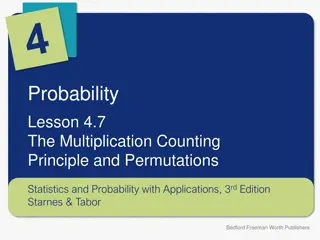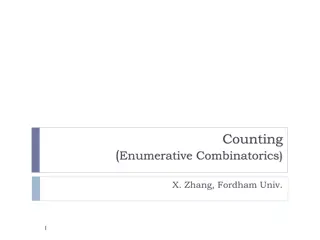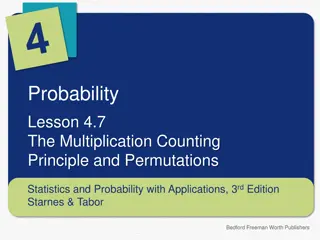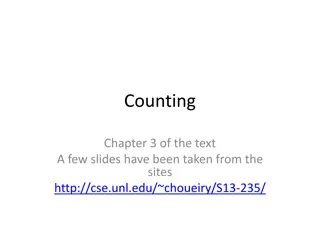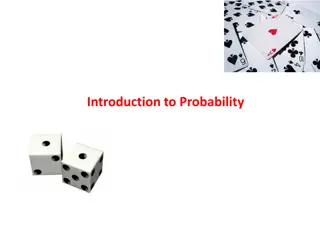Understanding Independence and Counting in Probability
Explore the concepts of independence, pairwise independence, common misconceptions, and counting principles in probability theory. Learn about permutations, combinations, and how to calculate possible outcomes in different scenarios.
Download Presentation

Please find below an Image/Link to download the presentation.
The content on the website is provided AS IS for your information and personal use only. It may not be sold, licensed, or shared on other websites without obtaining consent from the author. Download presentation by click this link. If you encounter any issues during the download, it is possible that the publisher has removed the file from their server.
E N D
Presentation Transcript
Independence-definition Two events are independent if there one event does not in any way effect the outcome of another. P(A|B) = P(A) This is the most common way it is portrayed and the easiest to understand, but more formally it is portrayed: B)=P(A)P(B) P(A
Common Misconceptions about Independence Disjointed is not the same as independent, in fact, they are nearly opposites. A B We often cannot tell independence by simply looking at a diagram like this.
More misconceptions Conditioning may affect independence For example: Kings and their siblings.
Pairwise Independence Pairwise independence simply is the relationship between two individual events. Pairwise independence of multiple events does not imply full independence of a sequence. Example: 1.22 from the book.
Counting In order to get a scope of (our sample space), we often need ways of counting all the possible outcomes to a given situation. If the events of a sequence are all independent of each other, then the Counting Principle can be applied. The Counting Principle states: Given a process r For every possible stage of the process there are ni possible results Then the total number of possible results are n1n2 nr Example: telephone number
Permutations Focuses on the selection of k objects out of a collection of n objects. Order of selection does matter and the items are not replaced after selection. n! Permutations= (n-k)! Example: marbles in a bag
Combinations Same thing as the above permutations, except that the order of selection doesn t matter: n! Combinations= k!(n-k)! Combinations are a partitioning of a group into a number of sections, then finding the total way they can be combined together. The above equation shows two partitions (k and not k) To find the real number of combinations simply divide the total permutations by the permutation of each partition. Example: Mississippi





